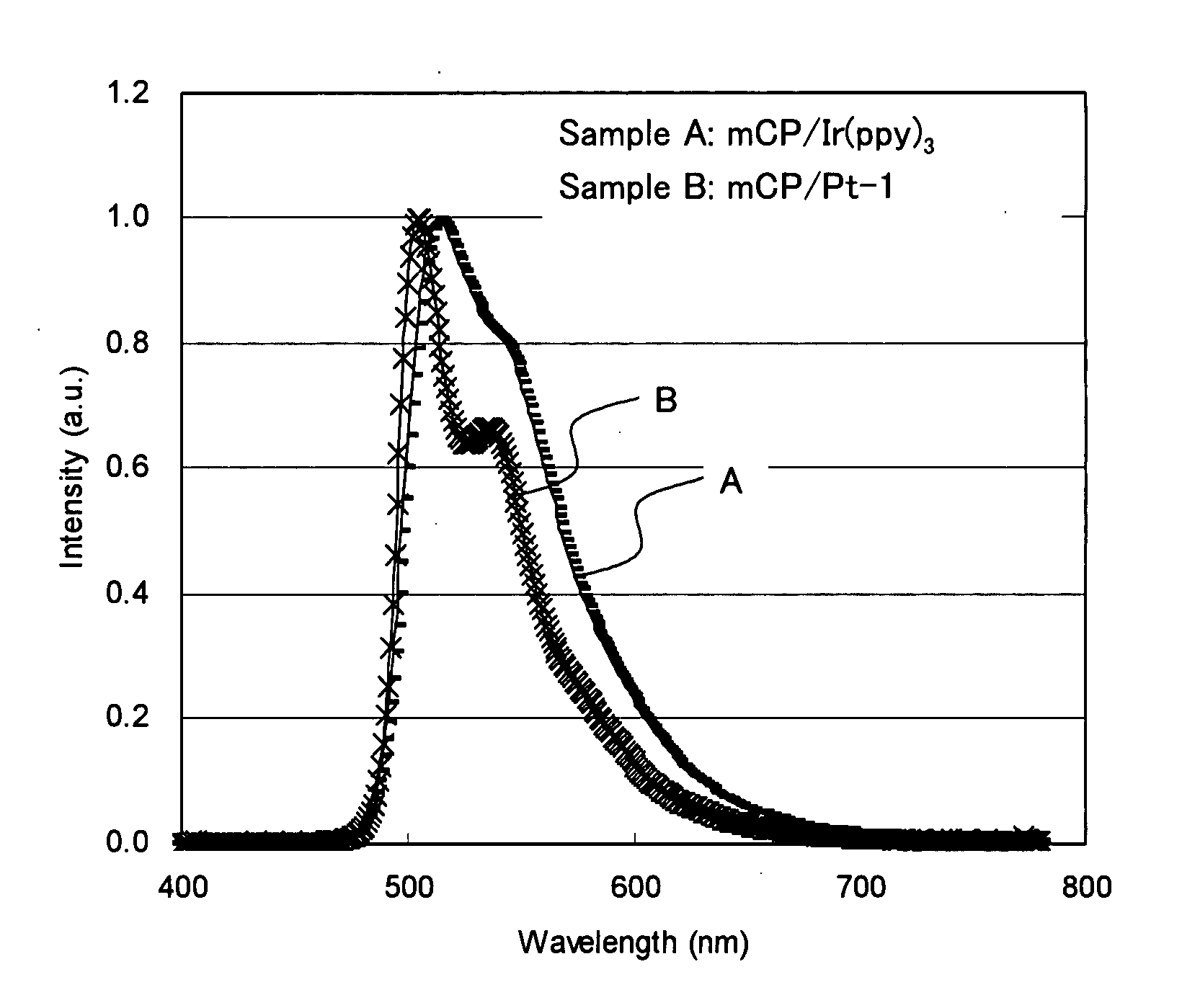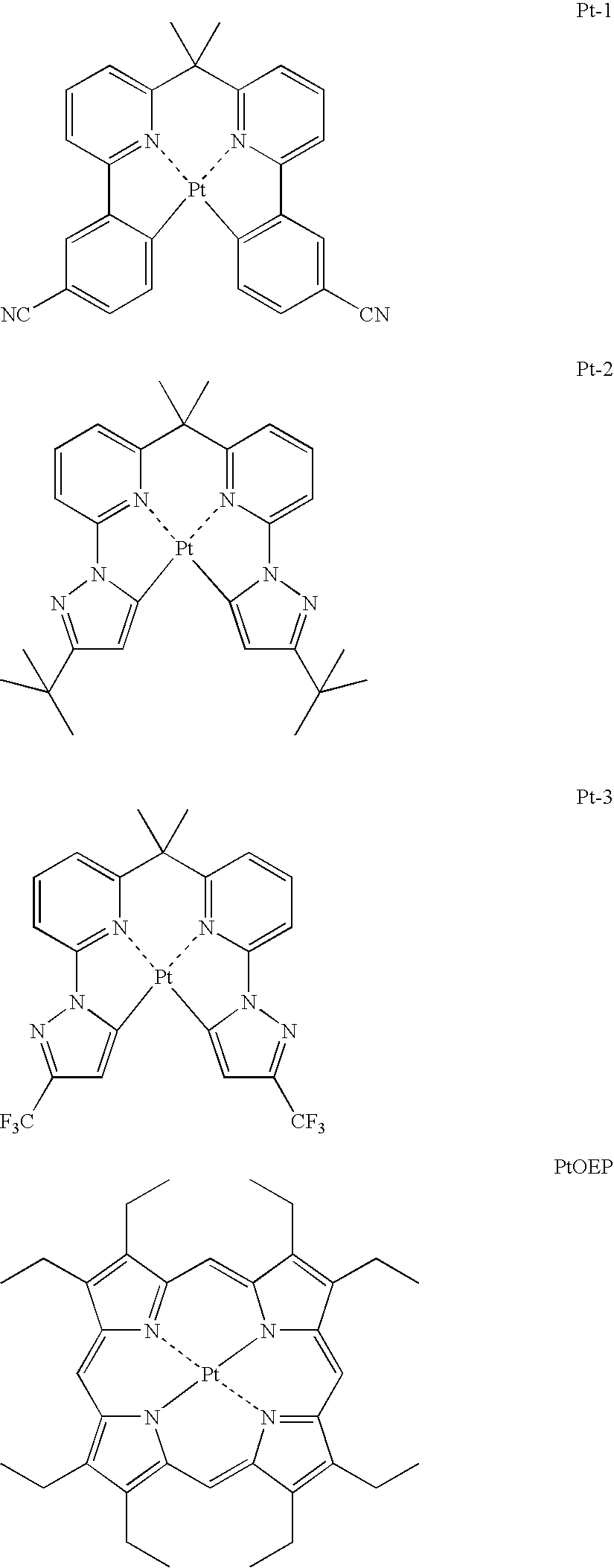Organic electroluminescent element and device
a technology of electroluminescent elements and organs, applied in the direction of discharge tubes/lamp details, luminescent compositions, discharge tubes/lamp details, etc., can solve the problems of radical deterioration of luminescent efficiency, and inability to achieve large improvement of luminescent efficiency
- Summary
- Abstract
- Description
- Claims
- Application Information
AI Technical Summary
Benefits of technology
Problems solved by technology
Method used
Image
Examples
example 1
1. Measurements of Ea Values, Ip Values and Light Emission Spectra for Light Emitting Materials
(Measurements of Ea Values and Ip Values)
[0186]Ea values and Ip values of three light emitting materials, such as mCP, Ir(ppy)3 and platinum complex Pt-1, were measured as follows.
[0187]Films for measurement were prepared by a vapor deposition on a glass substrate at a film thickness of 100 nm. Ip value of the obtained samples was measured by Spectrophotometer AC-2 (manufactured by Riken Keiki Co., Ltd.) at a light intensity of 20 nW under an ambient atmospheric environment.
[0188]Further, films for measurement were prepared by a vapor deposition on a quartz substrate at a film thickness of 100 nm. A spectral absorption of samples obtained over wavelengths of 180 nm to 700 nm was measured by using a Hitachi Spectrophotometer Model U3310 (manufactured by Hitachi Ltd.). Then, an energy gap value (Eg(ev)) was calculated from the absorption end of the obtained absorption spectrum at the longest...
example 2
1. Preparation of Organic EL Element
[0224]1) Preparation of Comparative Organic EL Element No. B1
[0225]A glass substrate having a thickness of 0.5 mm and a rectangular of 2.5 cm was put in a washing vessel, and washed with ultrasonic in 2-propanol, followed by an UV-ozone treatment for 30 minutes. The following layers were diposited on the transparent anode by a vacuum evaporation method. The evaporation speed of the vacuum evaporation method in Examples of the present invention is usually 0.2 nm / second unless it is insisted. The evaporation speed was measured by using a quartz resonator. The film thicknesses described below were also measured by the quartz resonator.
[0226]Anode: ITO (Indium Tin Oxide) was desposited on a grass substrate to have a film thickness of 100 nm.
[0227]Positive hole injection layer: 2-TNATA was deposited on the anode (ITO) at a film thickness of 100 nm.
[0228]Positive hole transport layer: α-NPD was desposited on the positive hole injection layer at a film t...
example 3
[0246]Organic EL element Nos. 4-12 were prepared in the same manner as that in the organic EL element No. 3, except that a composition of the light emitting layers and the other layers was changed as described in Table 5. The samples obtained were evaluated in the same manner as that in Example 2.
[0247]As is apparent from Table 5, it is noted that the organic EL elements of the present invention provide extremely high external quantum efficiency at a high light emission, and thereby, it results to save a consumption of an electric power through driving at a high current density.
TABLE 5ExternalQuantumEfficiencyFirst Light Emitting LayerThird Light Emitting Layeratat(Adjacent to Hole TransportThicknessSecond LightThickness(Adjacent to ElectronThickness1,0001,000Sample No.Layer)(nm)Emitting Layer(nm)Transport Layer)(nm)cd / m2cd / m2Inventive Sample No. 4mCP / 15% by weight Pt-115——mCP / 8% by weight156.3%9.3%Ir(ppy)2(ppz)Inventive Sample No. 5mCP / 3% by weight PtOEP15——mCP / 6% by weight153.3%7....
PUM
 Login to View More
Login to View More Abstract
Description
Claims
Application Information
 Login to View More
Login to View More - R&D
- Intellectual Property
- Life Sciences
- Materials
- Tech Scout
- Unparalleled Data Quality
- Higher Quality Content
- 60% Fewer Hallucinations
Browse by: Latest US Patents, China's latest patents, Technical Efficacy Thesaurus, Application Domain, Technology Topic, Popular Technical Reports.
© 2025 PatSnap. All rights reserved.Legal|Privacy policy|Modern Slavery Act Transparency Statement|Sitemap|About US| Contact US: help@patsnap.com



